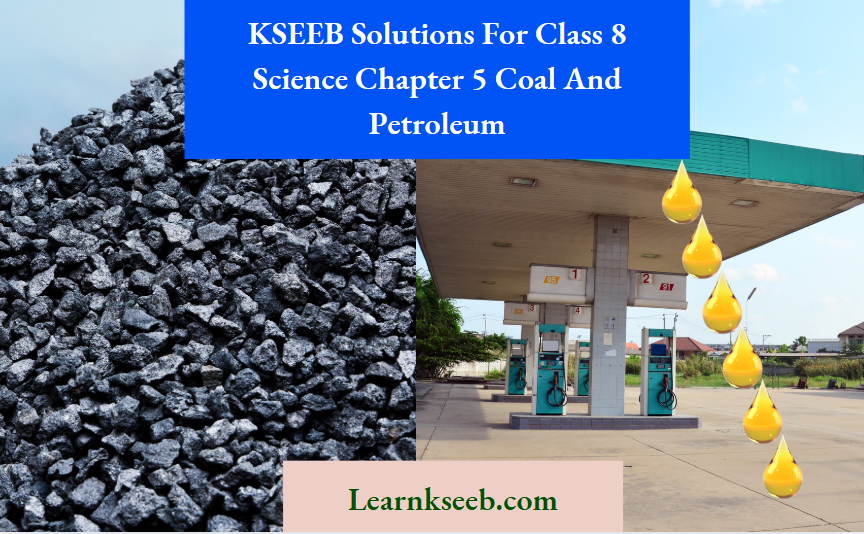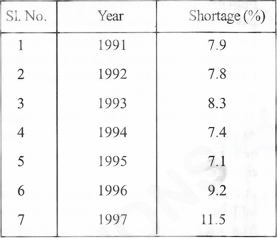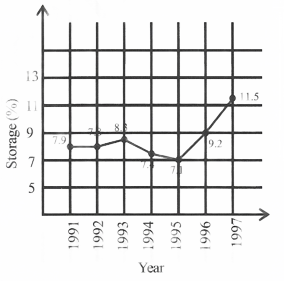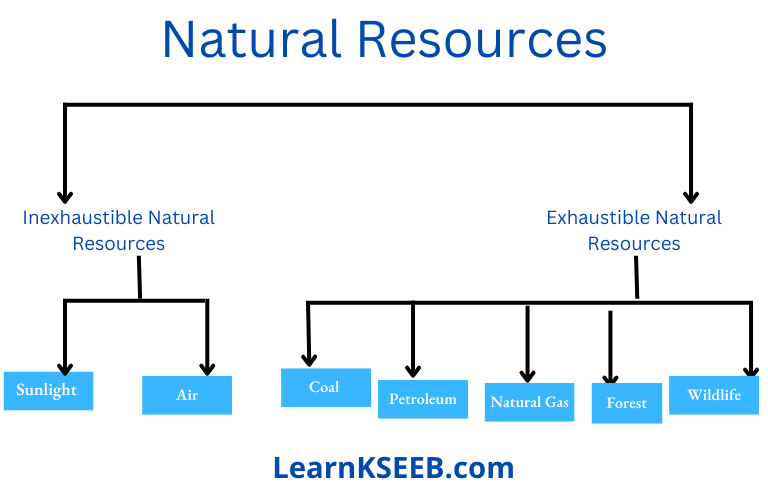KSEEB Class 8 Science Chapter 5 Coal And Petroleum Points To Remember
Natural Resources: Resources available in nature for the welfare of mankind.
Types of Natural resources:
Inexhaustible: Resources present in unlimited nature and will not be exhausted even if used continuously. Example: Sunlight, air.
Exhaustible: Resources which are limited and can soon get exhausted because of excessive use Example: Coal, petroleum, natural gas
Fossil fuels: Fuels formed by the natural bacterial decomposition of buried dead plants and animals under extreme temperature and pressure.
Carbonisation: The slow process of conversion of dead vegetation into coal.
Destructive distillation: The process of heating a complex substance in a limited supply of air so that it breaks down to form simpler substances.
Coke, coal tar and coal gas are the main products of the destructive distillation of coal.
Peat, lignite, bituminous and anthracite are the four types of coal.
Petroleum is also called crude oil or black gold.
Fractional Distillation: The process of refining petroleum in refineries based on their boiling points.
Petroleum gas, petrol, naphtha, kerosene, diesel, fuel oil, lubricating oil and bitumen are products obtained from fractional distillation petroleum.
Natural gas is found under the crust of the earth above the layers of petroleum.
Natural gas mainly consists of methane.
Excessive burning of fossil fuels releases carbon dioxide which traps solar radiation in the atmosphere and causes the greenhouse effect and leads to global warming.
Petrochemicals: Chemicals derived from petroleum or natural gas.
We should use fossil fuels judiciously.

KSEEB Solutions for Class 8 Science Chapter 5 Coal and Petroleum PDF
Coal And Petroleum Ncert Textbook Exercises
Question 1. What are the advantages of using CNG and LPG as fuels?
Answer:
The advantages of using CNG and LPG as fuels are :
- They can be burnt directly
- They can be transported easily through pipelines
- They are clean fuels and do not give smoke when burnt
- They give a lot of heat energy when burnt
Question 2. Name the petroleum product used for surfacing roads.
Answer: Bitumen
Question 3. Describe how coal is formed from dead vegetation. What is this process called?
Answer: Millions of years ago, dense forests got buried under the soil due to natural processes like storms, floods and earthquakes. These got compressed as more and more soil got deposited over them. When they got buried deep in the soil, they were exposed to very high pressure and temperature. Under these conditions, they slowly got converted into coal. This process of the formation of coal from dead vegetation is called carbonisation.
Question 4. Fill in the blanks :
1) Fossil fuels are_____ and _______
2) Process of separation of different constituents from petroleum is called ______
3) Least polluting fuel for vehicles is _______
Answer:
1) Coal, petroleum and natural gas
2) refining
3) compressed natural gas
Question 5. Tick True/False against the following statements.
1) Fossil fuels can be made in the laboratory (T/F)
2) CNG is a less polluting fuel than petrol and diesel (T/F)
3) Coke is an almost pure form of carbon (T/F)
4) Coal tar is a mixture of various substances (T/F)
5) Kerosene is not a fossil fuel (T/F)
Answer:
(1) False
(2) True
(3) False
(4) True
(5) False
Karnataka Board Class 8 Science Chapter 5 Solutions
Question 6. Explain why fossil fuels are exhaustible natural resources.
Answer: Fossil fuels take millions of years to be formed. They are limited in nature and cannot be replenished easily once consumed. Hence, they are considered as exhaustible natural resources.
Question 7. Describe the characteristics and uses of coke.
Answer:
Characteristics of coke
- Tough
- Porous
- Black in colour
- Produce a very little smoke
- Uses of coke
- Manufacture of steel Year
- Good reducing agent
- As fuel and producing water gas
Question 8. Explain the process of formation of petroleum.
Answer: Petroleum was formed from dead organisms that got buried in the sea millions of years ago. These dead bodies got covered with layers of sand and Natural clay. Lack of air, high temperature and high pressure transformed these dead organisms into petroleum and natural gas.
Question 9. The following table shows the total power shortage in India from 1991 – 1997. Show the data in the form of a graph. Plot shortage percentage for the years on the Y- axis and the year on the X-axis.

Answer:

Coal and Petroleum Class 8 KSEEB Solutions with Answers
Coal And Petroleum Activities
Question 1. Make a list of various materials used by us in daily life and classify them as natural and man-made
Answer:
Natural
- Air
- Sunlight
- Water
- Minerals
- Forests
Man-made
- Clothes
- Plastics
- Fan
- Cement
- Cosmetics
Coal And Petroleum Additional Questions
Question 1. What does CNG stand for?
Answer: Compressed Natural gas.
Question 2. Name the petroleum product used as fuel for stores, lamps and jet aircraft.
Answer: Kerosene
Question 3. Expand PCRA
Answer: Petroleum Conservation Research Association.
Question 4. While driving what are the tips we must follow to save petrol/diesel / natural gas?
Answer:
- Ensure correct tyre pressure
- Ensure regular maintenance of the vehicle
- Drive at a constant and moderate speed
- Switch off the engine at traffic lights or at a place where you have to wait.
Question 5. We read in newspapers that the burning of fuels is a major cause of global warming. Explain why?
Answer: Fossil fuels are generally mixtures of carbon-based compounds. On burning fossil fuels such as coal, petroleum and natural gas, produce carbon dioxide gas which is a greenhouse gas. The increase in levels of carbon dioxide in the atmosphere causes global warming.
Question 6.
1) What will happen if all the coal and petroleum reserves are depleted?
2) What can be done by you to prevent the depletion of coal and petroleum?
Answer:
- If all the coal and petroleum reserves are depleted, we will not have fuels for our vehicles, factories and houses as they take a very long time to replenish.
- We can prevent the depletion of coal and petroleum by following the ways
- Use alternative fuels.
- Use public transport and bicycles for short distances.
- Use carpools to go to work or to school.
Question 7. Name some renewable sources of energy.
Answer: Water, wind, solar.
Question 8. Give some examples of fossil fuels.
Answer: Coal, petroleum, natural gas.
Question 9. Name the elements present in coal.
Answer: Carbon, oxygen and sulphur.
KSEEB Class 8 Science Coal and Petroleum Exercise Solutions
Question 10. List four varieties of coal.
Answer: Peat, lignite, bituminous, anthracite.
Question 11. Write the full form of LPG.
Answer: Liquefied Petroleum Gas.
Question 12. What is the purest form of carbon?
Answer: Coke
Question 13. Name three constituents of petroleum and write their uses also.
Answer:
The three constituents of petroleum are:
- Petrol
- Paraffin wax
- Diesel
Uses:
Petrol: It is used as a motor fuel and for dry cleaning.
Paraffin wax: It is used for making ointments, candles, vaseline, etc.
Diesel: It is used as a fuel for heavy motor vehicles and electric generators.
Question 14. Name two products that you obtain from the destructive distillation of coal. What is the residue left in this process? Give one main use of this residue.
Answer:
- The two important products obtained from the destructive distillation of coal are Coal gas and coal tar.
- The residue left in this process is coke. Coke is used mainly as a reducing agent in the extraction of metals.
Question 15. Define the term ‘petrochemicals’.
Answer: Petrochemicals are substances obtained from petroleum and natural gas. They are used in the manufacture of detergents, fibres, polythene, etc.
KSEEB Class 8 Chapter 5 Coal And Petroleum Multiple Choice Questions
Question 16. Various materials which are obtained from nature are called natural resources. Which of the following is not a natural resource?
1. Minerals
2. Water
3. Soil
4. Plastic
Answer: 4. plastic
Explanation: Minerals, water and soil are natural resources whereas plastic is a man-made substance.
Question 17. Air is a natural resource and cannot be exhausted by human activities. It is known as an inexhaustible natural resource. Which of the following is another inexhaustible natural resource?
1. Coal
2. Petroleum
3. Sun-light
4. Minerals
Answer: 3. Sun-light
Explanation: Coal, petroleum and minerals are non-renewable sources of energy, which can get exhausted whereas sunlight is a renewable resource.
Karnataka Board 8th Science Chapter 5 Important Questions and Answers
Question 18. Which of the following is a pair of exhaustible natural resources?
1. Coal and soil
2. Air and sunlight
3. Water and petroleum
4. Wildlife and minerals
Answer: 4. Wildlife and minerals
Explanation: Coal and Soil, air and sunlight, water and petroleum. All these natural resources cannot be exhausted by human consumption and other uses. Wildlife and minerals are exhaustible natural resources, which are available in limited quantities and will be exhausted as a result of continuous use.
Question 19. Coal is processed in industries to get some useful products. Which of the following is not obtained from coal?
1. Coke
2. Coal tar
3. Coal gas
4. CNG
Answer: 4. CNG
Explanation:
- CNG is compressed natural gas which is made by compressing the natural gas.
- CNG is a petroleum product whereas coke, coal tar and coal gas are obtained from coal.
Question 20. Exhaustible natural resources are:
1. Unlimited in quantity.
2. Not dependent on nature.
3. Limited in quantity.
4. Not exhausted by human activities.
Answer: 3. Limited in quantity.
Explanation: Exhaustible natural resources are limited resources, which are available in limited quantities and are going to be exhausted by continuous human use. Wildlife, petroleum, water and minerals are examples of Exhaustible natural resources.
Question 21. Fossil fuels are obtained from:
1. Remains of non-living materials.
2. Dead remains of birds only.
3. Dead remains of insects only.
4. Dead remains of living organisms.
Answer: 4. Dead remains of living organisms
Explanation: Fossil fuels are obtained millions of years ago remains of dead remains of living organisms. Get buried under the earth.
Question 22. Coal is formed from the remains of
1. Vegetation only
2. Animals only
3. Both vegetation and animals
4. Neither vegetation nor animals
Answer: 1. Vegetation only
Explanation: Coal is a fossil fuel formed from the remains of prehistoric plants or animals. The formation of coal occurs over millions of years via a process known as carbonation.
KSEEB Class 8 Science Chapter 5 Textbook Solutions
Question 23. Which substance is formed by the carbonisation of dead vegetation?
1. Coal
2. Coke
3. Coal gas
4. Coal tar
Answer: 1. Coal
Explanation: The formation of coal occurs over millions of years via a process known as carbonation. In this process, dead vegetation is converted into carbon-rich coal under very high temperatures and pressure.
Question 24. Naphthalene balls are obtained from coal tar and are used as:
1. Mosquito repellant
2. Honey bee repellant
3. Moth repellant
4. Snake repellant
Answer: 3. Moth repellant
Explanation: Naphthalene balls are chemical pesticides and deodorants, the characteristic smell of naphthalene makes the insects and moths run away from naphthalene stored under clothes etc.
Question 25. Which of the following is not a constituent of petroleum
1. Paraffin wax
2. Lubricating oil
3. Petrol
4. Coke
Answer: 4. Coke
Explanation: Coke is not a constituent of petroleum. It is almost a pure form of carbon.
Question 26. Petroleum was formed from organisms:
1. Living on the land
2. Living on the plants
3. Living in the sea
4. Living on the rocks
Answer: 3. Living in the sea
Explanation: Petroleum was formed from organisms living in the sea. As these organisms died, their bodies settled down at the bottom of the sea and got covered with layers of sand and clay. Over millions of years, the absence of air, high temperature and high pressure transformed the dead organisms into petroleum and natural gas.
Question 27. Choose the incorrect statement from the following:
1. It is difficult to transport natural gas through pipes.
2. The disadvantage of natural gas is that it can not be used directly for burning in homes.
3. Natural gas is stored under high pressure as compressed natural gas.
4. Natural gas cannot be used for power generation.
Answer: 1. It is difficult to transport natural gas through pipes.
Explanation: Natural gas is a naturally occurring hydrocarbon gas, which is extracted from the petroleum deposits deep beneath the earth. It isa highly flammable gas, therefore, it is difficult to transport through pipes.
KSEEB 8th Standard Science Chapter 5 Notes and Solutions
Question 27. You are provided with a mixture of petroleum and water. Can you suggest a method to separate the two?
Answer: Decantation is the method used to separate a mixture of petroleum and water.
Question 28. Name the petroleum product used as fuel for stoves, lamps and jet aircraft.
Answer: Kerosene is the petroleum product used as fuel for stoves, lamps and jet aircraft.
Question 29. Fill in the blanks in the following sentences.
1.Cialis one of the ________used to cook food.
2. When heated in air, coal burns and produces mainly _____ gas.
3. Coal tar is black and thick with an _______ smell.
4.Petroleum, _____ and _____ are fossil fuels.
5. Forests and coal are _____ natural resources.
Answer:
1. Fuel
2. Carbon-di-oxide-gas
3. Thick
4. Coal
5. Exhaustible
Question 30. The underlined words in the following sentences have been jumbled up. Write them in their correct form.
1. Loca is obtained from mines.
2. Umpetlore is a fossil fuel.
3. Rineryfe is a place where various fractions of petroleum are separated.
4. Keenrose is a fuel used in jet crafts.
5. Nutsgilh is an example of inexhaustible natural resources.
Answer:
1. Coal
2. Petroleum
3. Refinery
4. Kerosene
5. Sunlight
Coal And Petroleum Class 8 Science KSEEB Guide
Question 31. Write True/False against the following statements.
1. Oxygen is an exhaustible natural resource.
2. Resources which are present in unlimited quantity in nature are called exhaustible natural resources.
3. Wildlife is an exhaustible natural resource.
4. Under high temperatures and pressure, dead plants get slowly converted to coal.
5. CNG is a less polluting fuel than petrol and diesel.
Answer:
1. False
Explanation: Oxygen is not an exhaustible natural resource.
2. False
Explanation: Resources which are present in unlimited quantity in nature are called inexhaustible natural resources.
3. True
4. True,
5. True.
Question 32. Sunlight and air are inexhaustible natural resources. Comment.
Answer: Sunlight and air are present in unlimited quantity in nature and are not likely to be exhausted by human activities or by any other means. Hence Sunlight and the air are inexhaustible natural resources.
Step-by-step Solutions for Coal and Petroleum Class 8 Karnataka Board
Question 33. Some natural resources are given in a box. Classify them into the exhaustible and inexhaustible natural resources.
Air, Coal, Natural gas, Sunlight, Petroleum, Minerals, Forests and Oxygen.
Answer:
Exhaustible Inexhaustible
Coal Air
Forests Oxygen
Minerals Sunlight
Petroleum Natural gas
Question 34. Write the characteristics and some important uses of coal.
Answer:
Characteristics of coal.
- It is a fossil fuel.
- It is Combustible.
- It is as hard as stone and is black in colour.
- When it is burned in the air it releases CO2
Uses of Coal
- Coal is one of the fuels used to cook food.
- Coal is also used as fuel in various industries.
- It is also used in thermal power plants to produce electricity.
- Earlier, it was used in railway engines to produce steam to run the engine.

Karnataka State Board Syllabus for Class 8 Textbooks Solutions
- Chapter 1 Crop Production and Management
- Chapter 2 Microorganisms: Friend and Foe
- Chapter 3 Synthetic Fibres and Plastics
- Chapter 4 Materials: metals and Non-Metals
- Chapter 6 Conservation of Plants and Animals
- Chapter 7 Force and Pressure
- Chapter 8 Friction
- Chapter 9 Sound
- Chapter 10 Combustion and Flame
- Chapter 11 Cell Structure and Functions
- Chapter 12 Reproduction in Animals
- Chapter 13 Reaching the age of Adolescence
- Chapter 14 Chemical Effects of Electric Current
- Chapter 15 Some Natural Phenomena
- Chapter 16 Light
- Chapter 17 Stars and the Solar System
- Chapter 18 Pollution of Air and Water
